
Back to Basics: July 2012
Mark Van
Features Fire Ground TrainingA mayday is initiated by a firefighters who are in trouble, lost, injured or trapped.
A mayday is initiated by a firefighters who are in trouble, lost, injured or trapped. Trapped firefighters need help from the rapid intervention team (RIT) to become untangled and removed from the building.
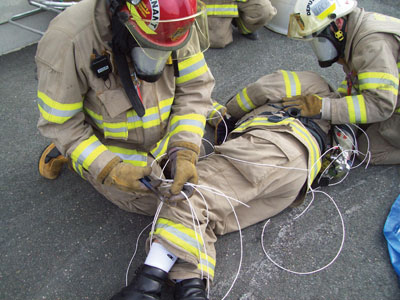 |
|
| A RIT member practises cutting wires. It is best to practise this skill in the dark. Photo by Mark van der Feyst
|
Some firefighter fatalities have been attributed to entanglements. On April 11, 1994, a Memphis Fire Department firefighter was killed after becoming tangled in cable television wires in the ceiling of a hallway outside a ninth-floor apartment; he was just nine feet away from the hallway exit door. The plastic clips that were holding the wires had melted and the cable wires fell on top of the firefighter. On Aug. 29, 2007, two firefighters from Massachusetts were killed in a restaurant when a ceiling collapsed, dumping the contents onto them. One firefighter was tangled in wires and debris, making the rescue effort difficult. There also have been numerous close calls reported, with firefighters attesting to being trapped by wires or other debris from ceilings.
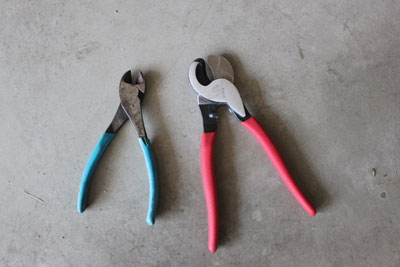 |
|
| Photo 1: RIT members should carry two types of wire cutters in two different pockets, for example, the radio pocket and the cargo pocket. |
|
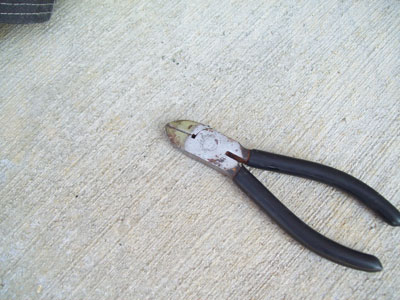 |
|
| Photo 2: Make sure that the wire cutters you use do not have a square stripping notch at the bottom of the blades; this will hinder cutting, and add to your frustration. Advertisement
|
|
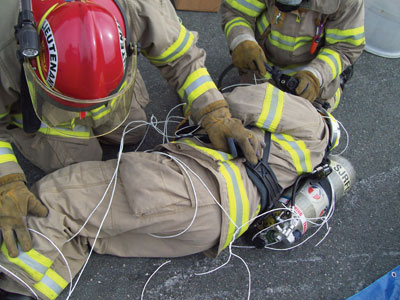 |
|
| Photo 3: A RIT member sweeps the trapped firefighter for signs of entanglement.
|
|
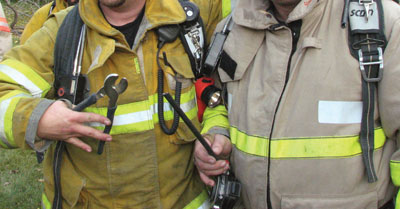 |
|
| Photo 4: Be careful to verify wires before cutting, ensuring that you don’t cut something necessary to the mayday firefighter’s survival, such as the low-pressure hose. Photos by Mark van der Feyst |
When firefighters become tangled by wires, time is critical as trapped firefighters must either free themselves using survival techniques or have a RIT member help them. The one thing firefighters must not do is panic, as this often results in a fight or flight response, an effort to get free of the wires and failure to call a mayday right away. RIT members have been trained to deal with entanglements and to free the mayday firefighter, but rescuers will be effective only if they are deployed right away.
All RIT members needs to carry at least one pair of wire cutters. It is best to carry two pairs, one in the radio pocket and the other in the cargo pocket of the pant. Cutters should be located on opposite sides; this ensures access to one or the other should one side become inaccessible due to collapse or other circumstances. The cutters need to be large enough to be used while wearing structural firefighting gloves, as seen in photo 1. The two types of cutters shown shown are the right size for operations under fire conditions. Make sure that the cutters do not have a square stripping notch at the bottom of the cutting blades as seen in photo 2. This notch adds to the frustration of trying to cut the wires.
Before mayday firefighters can be extricated, part of the nine-step assessment process ensures that they are not entangled by wires, ceiling grid members, HVAC piping, dryer vent hose or any other ceiling content. As you can see in photo 3, one of the RIT firefighters is sweeping the body of the trapped firefighter from top to bottom to ensure there are no entanglements. This is an important step in the nine-step process and it requires careful attention; just running your hands up and down or trying to see any wires or obstructions is not good enough. Use your hands around the SCBA cylinder, the face piece, the helmet, the chest gauge, and the feet and arms to make sure that no wires are present; do this in the area around the mayday firefighter as well. Looking up and around or feeling around above the mayday firefighter ensures that there are no entanglements that can complicate the rescue operation.
Any entanglements found around the mayday firefighter must be removed by RIT members. Wires, which are among the most common obstructions for firefighters, can simply be cut with wire cutters. It’s important to pay careful attention to what you are cutting; cutting while wearing structural firefighting gloves is difficult. It is best to grab a few strands of the wires and place them into the wire cutter at the very bottom of the blades (see photo 4). This ensures that the cut goes through the wires rather than just nicking them and possibly cutting through only some of the wires. It’s also a good idea to putting tension on the wire while it is in the mouth of the cutter. Be careful to not place your fingers in the cutters. Practising this skill while blacked out sharpens the senses makes rescuer proficient at this task.
Photo 5 shows a mayday firefighter being rescued by RIT members and one of the rescuers becoming entangled. In this instance, the other RIT firefighter returned to free the first firefighter. In an attempt to free him quickly (his low-air alarm was going off), the RIT firefighter grabbed what he thought was the wire and cut it. Right away, the results of the action were heard, as air was leaking out from the low-pressure hose. This speeds up the clock against rescuers. Verify before you cut any wires that whatever you are cutting is not the SCBA hose of the mayday firefighter or that of another RIT member.
Practising this operational technique will pay off when the time comes to untangle a mayday firefighter from wires. Remember to verify before you cut.
Mark van der Feyst is a 13-year veteran of the fire service. He works for the City of Woodstock Fire Department in Ontario and instructors in Canada, the United States and India. Mark is a local level suppression instructor for the Pennsylvania State Fire Academy and an Instructor for the Justice Institute of B.C., Contact him at Mark@FireStarTraining.com
Print this page